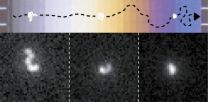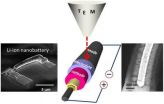(Press-News.org) Remember Slinky®, the coiled metal spring that "walks" down stairs with just a push, momentum and gravity? Researchers at the National Institute of Standards and Technology (NIST) have developed their own version of this classic—albeit 10 million times smaller—as a novel technology for manipulating and measuring DNA molecules and other nanoscale (billionth of a meter) materials.
In the first of two recent papers,* Samuel Stavis, Elizabeth Strychalski and colleagues demonstrated that a nanoscale fluidic channel shaped like a staircase with many steps (developed previously at NIST and Cornell University**) can be used to control the otherwise random drift of a DNA molecule through a fluid. Squeezed into the shallowest step at the top of the staircase, a strand of DNA diffuses randomly across that step. The DNA molecule seeks to increase its entropy—the universal tendency towards disorder in a system—by relieving its confinement, and therefore, "walks" down onto the next deeper step when it reaches the edge. The motion of the molecule down the staircase, which the researchers termed "entropophoresis" (entropy-driven transport), ends when it becomes trapped on the deepest step at the bottom. Because this motion resembles that of a Slinky®, the researchers nicknamed their system the "nanoslinky." The researchers found that DNA molecules of different sizes and shapes descended the staircase at different rates—which suggests the structure could be used to separate, concentrate and organize mixtures of nanoscale objects.
Stavis says that this novel technology provides advantages over traditional nanofluidic methods for manipulating and measuring DNA. "Control over the behavior of a DNA molecule is built into the staircase structure. After placing the molecule on the top step [by driving the DNA strand up the staircase with an electric field], no external forces are needed to make it move," Stavis says. "The staircase is a passive nanofluidic technology that automates complex manipulations and measurements of DNA."
This NIST advance in nanofluidic technology dovetails nicely with a NIST innovation in measurement science—specifically, determining the size of a DNA molecule in nanofluidic "slitlike confinement" imposed by the narrow gap between the floor of each step and the ceiling of the channel. In the "nanoslinky" system, Strychalski explains, the coiled and folded DNA strand contracts progressively as it moves down the steps. "Because there are many steps, we can make more detailed measurements than previous studies," she says.
Getting the most from those measurements was the goal of the research reported in the NIST team's second paper. *** "The challenge was to make our measurements of DNA size more quantitative," Strychalski says.
Previous measurements of DNA dimensions in nanofluidic systems, Strychalski says, have been limited by imaging errors from the optical microscopes used to measure the dimensions of DNA molecules labeled with a fluorescent dye. "The first problem is the diffraction limit, or the optical resolution, of the fluorescence microscope," she says. "The second problem is the pixel resolution of the camera. Because a DNA molecule is not much larger than the wavelength of light and the effective pixel size, images of fluorescent DNA molecules are blurred and pixilated, and this increases the apparent size of the molecule."
To improve their measurements of DNA molecules during their descent, the NIST researchers used models to approximate the effects of diffraction and pixilation. Applying these "numerical simulations" to the images of DNA molecules confined by the staircase made the final measurements of DNA size the most quantitative to date. These measurements also showed that more work is needed to fully understand this complicated system.
According to Stavis and Strychalski, the staircase is a simple prototype of a new class of engineered nanofluidic structures with complex three-dimensional surfaces. With further refinements, the technology may someday be mass produced for measuring and manipulating not just DNA molecules, but other types of biopolymers and nanoscale materials for health care and nanomanufacturing.
INFORMATION:
Slinky® is a registered trademark of POOF-Slinky, Inc.
* S.M. Stavis, J. Geist, M. Gaitan, L.E. Locascio and E.A. Strychalski. DNA molecules descending a nanofluidic staircase by entropophoresis. Lab on a Chip (2012). DOI: 10.1039/c21c21152a.
** See the April 7, 2009, Tech Beat article "World's First Nanofluidic Device with Complex 3-D Surfaces Built" at www.nist.gov/public_affairs/tech-beat/tb20090407.cfm#nanofluidic.
*** E.A. Strychalski, J. Geist, M. Gaitan, L.E. Locascio and S.M. Stavis. Quantitative measurements of the size scaling of linear and circular DNA in nanofluidic slitlike confinement. Macromolecules (2012). DOI: 10.1021/ma202559k.
'Nanoslinky': A novel nanofluidic technology for DNA manipulation and measurement
2012-03-22
ELSE PRESS RELEASES FROM THIS DATE:
An Easy Way to Make Custom Vinyl Lettering
2012-03-22
http://vinylletter.net specializes making custom vinyl lettering. With http://vinylletter.net what you see is what you get online editor, you can easily custom whole piece vinyl letter you want. We promise quality and fast delivery. http://vinylletter.net can let you specify letter spacing and line spacing for your vinyl lettering. ...
Sexual offenses between inmates occur less often in states that allow conjugal visitation
2012-03-22
Could widespread conjugal visitation reduce sexual offending in prisons? It's a possibility, according to Stewart D'Alessio and his team from Florida International University in the US. Their work shows that in states where conjugal visits are permitted, there are significantly fewer instances of reported rape and other sexual offenses in their prisons. The study is published online in Springer's American Journal of Criminal Justice.
At present, there are two opposing theories of the causes of sexual violence. The feminist perspective asserts that sexual violence is motivated ...
Stress management for breast cancer patients may affect disease course
2012-03-22
CORAL GABLES, FL (March 21, 2012)—A team of researchers led by Michael H. Antoni, director of the Center for Psycho-Oncology Research at the University of Miami (UM) has shown that a stress management program tailored to women with breast cancer can alter tumor-promoting processes at the molecular level. The new study recently published in the journal Biological Psychiatry is one of the first to link psychological intervention with genetic expression in cancer patients.
According to the study, the group-based Cognitive-Behavioral Stress Management (CBSM) intervention ...
Cardinal Web Solutions Reminds Businesses the Clock is Ticking to Adapt on Facebook
2012-03-22
According to Cardinal Web Solutions, an Internet marketing firm in Atlanta, all business pages on Facebook will be converted to the Timeline format on March 30th 2012. While this may be the biggest change from a visual standpoint, the changes to features and the heretofore virtually unlimited versatility that has made Facebook an essential social media marketing tool will be a hard pill to swallow for many businesses.
Communications sent thru Facebook by businesses are being throttled to 16% per month of current Facebook fans that have "liked" your page. This ...
Nanopower: Avoiding electrolyte failure in nanoscale lithum batteries
2012-03-22
It turns out you can be too thin—especially if you're a nanoscale battery. Researchers from the National Institute of Standards and Technology (NIST), the University of Maryland, College Park, and Sandia National Laboratories built a series of nanowire batteries to demonstrate that the thickness of the electrolyte layer can dramatically affect the performance of the battery, effectively setting a lower limit to the size of the tiny power sources.* The results are important because battery size and performance are key to the development of autonomous MEMS—microelectromechanical ...
Study: Stress-induced cortisol facilitates threat-related decision making among police officers
2012-03-22
NEW YORK – March 21, 2012 – Research by Columbia Business School's Modupe Akinola, Assistant Professor, Management, and Wendy Berry Mendes, Associate Professor, Sarlo/Ekman Endowed Chair of Emotion, University of California San Francisco in Behavioral Neuroscience examines how increases in cortisol, brought on by an acute social stressor, can influence threat-related decision making. The researchers studied a group of police officers completing a standardized laboratory stressor and then afterwards the group completed a computer simulated threat-related decision making ...
Nemours researchers uncover new evidence of cancer-causing agent present in gaseous phase of cigarette smoke
2012-03-22
Wilmington, DE— A team of researchers led by A. K. Rajasekaran, PhD, Director of the Nemours Center for Childhood Cancer Research, has shown that a key protein involved in cell function and regulation is stopped by a substance present in cigarette smoke. Their work is published online in the American Journal of Physiology - Lung Cell and Molecular Physiology.
Cigarette smoke is well recognized as a cause of lung cancer and is associated with many other forms of cancer in adults. Cigarette smoke has more than 4,000 components, many of which are linked to the development ...
Geosphere's dynamic platform displays the latest 3-D modeling, LiDAR imaging, and more
2012-03-22
Boulder, Colo., USA – Highlights include new entries to the special issues "Seeing the True Shape of Earth's Surface" and "Origin and Evolution of the Sierra Nevada and Walker Lane." Also online: 3-D modeling of the area in the Pacific Ring of Fire affected by the magnitude 8.1 earthquake on 29 Sept.; another article comparing three different 3-D modeling software packages; and the identification of ancient marine terraces in areas of dense tree cover using airborne LiDAR.
Abstracts for these and other Geosphere papers are available at http://geosphere.gsapubs.org/. Representatives ...
Data from MESSENGER spacecraft reveals new insights on planet Mercury
2012-03-22
(Santa Barbara, Calif.) ––Thanks to the MESSENGER spacecraft, and a mission that took more than 10 years to complete, scientists now have a good picture of the solar system's innermost planet.
On March 17, MESSENGER (MErcury Surface, Space Environment, GEochemistry, and Ranging) completed its one-year primary mission, orbiting Mercury, capturing nearly 100,000 images, and recording data that reveals new information about the planet's core, topography, and the mysterious radar bright material in the permanently shadowed areas near the poles. The findings are presented ...
Competitive Advantage Even More Important in a Recession (How to Use Creativity and Innovation to Become Number One in Your Industry)
2012-03-22
"Business owners are being squeezed from all angles. Rising gas prices, increased regulations and unemployment all affect the bottom line. When no one is hiring, more people begin starting their own businesses or become consultants. Basically, you have more people trying to get less business. And that means there's more competition. But there is one thing you can do to get a head start on your competition, and that's through innovation.
"Innovation isn't just about creating new products", says Julie Austin, whose company Creative Innovation, teaches businesses ...




